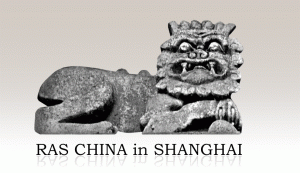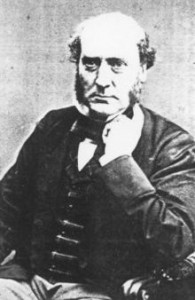Posted: March 5th, 2011 | 1 Comment »
In 1939 a new paper entered the Shanghai market with an English name but written in German – the Shanghai Jewish Chronicle. Under the editorship of founder Ossie Lewin and two Viennese journalists – Ladislaus Frank and Dr Mark Siegelberg – it became the Jewish community’s paper of record in China and a major challenger to Die Gelbe Post. It was sanctioned by the Japanese authorities and they used to it to publicise instructions to the displaced Jewish community and so it lasted through the War years and longer, renaming itself the Shanghai Echo and remaining in print until 1948. By 1939 there were around 12 Jewish periodicals being regularly published in Shanghai with a host of others that were short-lived. All could be found at Shanghai’s major Jewish run bookstores – The Lion and The Paragon. Ossie Lewin particularly was a fixture of Jewish cultural life in Shanghai; Chairman of the European Jewish Artists Society and an active leader of the German-speaking Zionists in the city. Frank was also well known in Shanghai, editing the Chronicle and also getting into some hard fought fights with the SMC in its dying days while Siegelberg eventually left for Australia where he founded the Neue Welt newspaper in Melbourne.
Hamilton Haus (House), the paper’s offices still stands magnificently in all its 1930s art-deco glory at the corner of Fuzhou (Foochow) and Jiangxi (Kiangse) Roads.

Posted: March 4th, 2011 | No Comments »
I have no idea what this tastes like or why anyone would offer a china mug with a bottle of wine…but it’s on sale now (in Taiwan only obviously!):

Posted: March 3rd, 2011 | No Comments »
Suzhou is to have its own chapter of the Royal Asiatic Society and Presidents Peter Hibbard (Shanghai) and Robert Nield (Hong Kong) will attend the inauguration with an opening talk by popular Shanghai-based historian and writer Tess Johnston, followed by a few words from RAS officers and members. So do come along and help us celebrate with wine, beer, nibbles and a good time to follow. The contact for the RAS in Suzhou is Bill Dodson, Suzhou resident and author of China Inside Out, who commented:
“I’m truly excited and honored to help inaugurate the RAS Suzhou Chapter. Suzhou is unique throughout Chinese history as a commercial and administrative centre of Jiangsu Province, and as an entrepot for Western explorers, businesspeople and journalists working to decode China. Suzhou still continues to attract Westerners and Chinese alike as a World Heritage Foundation City, and as a major destination for foreign and domestic investment. I’m looking forward through RAS events in the area to explore the city’s rich heritage, its impact on Chinese and Western history, and its role in shaping the future.”
If you’re near Suzhou on Sunday do pop along – the event is free
The Suzhou Bookworm, Gunxiu Fang 77, Shi Quan Jie. For more information and to RSVP, contact Bill Dodson at 135 0613 6662.

Posted: March 3rd, 2011 | No Comments »
A link here to a discussion about Britain’s history in China that was aired on BBC Radio 3’s Night Waves arts programme. Rana Mitter and Robert Bickers chat about the latter’s new book The Scramble for China. Some interesting points made though, I’d argue, a rather inflated belief in how knowledgeable or nuanced those who’ve been through the post-1989 Chinese education system are on the period. The other speakers are less interesting with the diplomat displaying all the commitment and spine on any issue China-related we’ve long come to expect of the modern FCO sadly (where on earth do they recruit all these completely characterless characters?). Still, good to see this history being talked about and sad that it really has no place on the modern history curriculum in UK schools. The BBC’s blurb below:
The British had a considerable imperial presence in China but we have largely forgotten about it. The Chinese, on the other hand, remember very clearly what they see as various humiliations at the hands of the imperious Brits. Rana Mitter is joined by historian Robert Bickers, film-maker Sun Shuyun and ex-diplomat Rod Wye to examine how these mismatched histories affect Anglo-Chinese relations even today.

Posted: March 2nd, 2011 | 3 Comments »
In among all the destruction ongoing in Shanghai, a small ray of light – the restoration of the Sir Gilbert Scott (below) designed Holy Trinity Church on Jiujiang Road (Kiukiang Road). I snapped the inside during refurbishment (here) some time ago. Now the Los Angeles Times has a long and detailed article on the church’s history and some shots of the apparently magnificent finished interior (only the stained glass to go).
Though religious sites around town continue to be destroyed, most notably recently the Jesuit Recoleta Mission in Frenchtown, this seems to be a victory for the good guys and the venue will apparently become a practicing church again. Hopefully this may encourage those restoring the Union Church on Suzhou Creek. I fear for that one as it lies within the area of land that seems to be totally controlled by the Rockbund Corporation (Rockefeller Development) who’s track record in Shanghai so far is rather alarming (unable to protect the Rowing Club and mucking about with various other buildings behind the Bund too and creating a nasty private guard patrolled atmosphere for anyone not either foreign or obviously wealthy – the city has basically allowed an entire street to be privatised!). The other day I tried to get into the Union Church but the private security goons were not having any of that!
 Hopefully Scott would have been pleased with the restoration
Hopefully Scott would have been pleased with the restoration
Posted: March 1st, 2011 | No Comments »

I’ll be moderating a couple of events with the terrific and versatile author Michel Faber at the Bookworm International Literary Festivals this year. Faber is a terrific writer who’s work is inspired by the Victorian, the Gothic and Scotland where he has lived and worked for many years. I’m greatly looking forward to these events in Suzhou and Beijing.
Michel Faber – Under the Skin
Suzhou Bookworm: Friday, 4 March – RMB30 (tickets on sale at the Suzhou Bookworm)
Beijing Bookworm Wednesday, 9 March 6pm – RMB50 (tickets on sale now at The Bookworm from 9am until 9pm)
Michel Faber is a best-selling literary master of the unsettling and unexpected. His stylistic virtuosity sets him apart, no two of his books are the same: each an unclassifiable blend of science fiction, horror, thriller, historical fiction, ghostliness and satire on modern life. From the Victorian back-alleys and prostitution of The Crimson Petal and the White to the spine-tingling hitchhiking horror of Under the Skin. Possessing a dark humour, graceful touch and vivid imagination, Faber speaks on his diverse body of work and his compulsion to write. Moderated by Paul French, author of Fat China and Through the Looking Glass.

Posted: March 1st, 2011 | 1 Comment »
 A slight cheat here perhaps as university campuses are often a bit better preserved than ordinary housing or property deemed to be of some commercial value. Nanjing University is one of China’s oldest surviving institutions and still rated fairly highly – you can go back to 258 CE, which is a bit of a stretch – the campus here is really from the university that was created in 1902 and flourished in the 1920s, obviously during the ‘Nanking decade’. There’s a whole load more history here if you want it. Anyway, on a sunny day it’s a nice stroll away from the wider Republican era boulevards that criss cross Nanking and there’s a bit of green to sit around on too.
A slight cheat here perhaps as university campuses are often a bit better preserved than ordinary housing or property deemed to be of some commercial value. Nanjing University is one of China’s oldest surviving institutions and still rated fairly highly – you can go back to 258 CE, which is a bit of a stretch – the campus here is really from the university that was created in 1902 and flourished in the 1920s, obviously during the ‘Nanking decade’. There’s a whole load more history here if you want it. Anyway, on a sunny day it’s a nice stroll away from the wider Republican era boulevards that criss cross Nanking and there’s a bit of green to sit around on too.




Posted: February 28th, 2011 | No Comments »
 Baiziting is close to yesterday’s stroll of Fuhougang but has perhaps suffered from having attention drawn to it – as we know in Shanghai nothing attracts the rapacious desires of the property developers than preservation orders!! Baiziting has been designated a ‘historical architecture area’ yet many of the older ‘Republican era’ properties here are in worse shape than Fuhougang and the developers are poking away nibbling at the edges and building inappropriate new modern buildings in the heart of the supposed ‘historical architecture area’ – a particularly hideous example appears to be a new express type hotel of boxlike dimensions and no architectural merit whatsoever. However, there are several pretty decent early 1930s properties on, or just off, Baiziting worth noting:
Baiziting is close to yesterday’s stroll of Fuhougang but has perhaps suffered from having attention drawn to it – as we know in Shanghai nothing attracts the rapacious desires of the property developers than preservation orders!! Baiziting has been designated a ‘historical architecture area’ yet many of the older ‘Republican era’ properties here are in worse shape than Fuhougang and the developers are poking away nibbling at the edges and building inappropriate new modern buildings in the heart of the supposed ‘historical architecture area’ – a particularly hideous example appears to be a new express type hotel of boxlike dimensions and no architectural merit whatsoever. However, there are several pretty decent early 1930s properties on, or just off, Baiziting worth noting:
 as you can see some are in good condition…
as you can see some are in good condition…
 and some in decidedly less good condition!
and some in decidedly less good condition!
 and this final shot is the front and balcony of the building above
and this final shot is the front and balcony of the building above

















